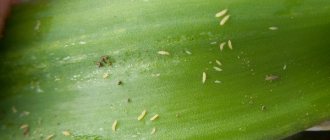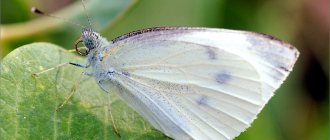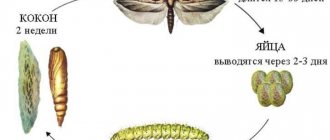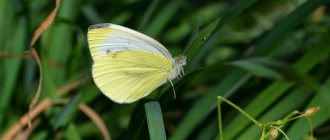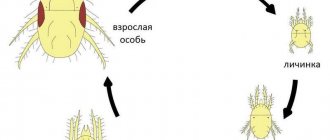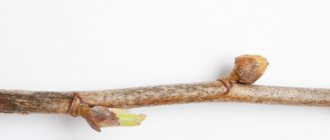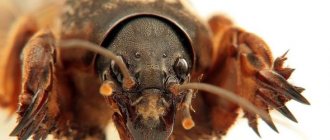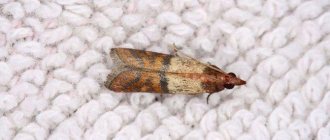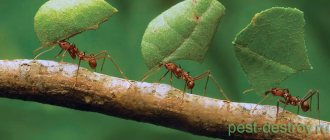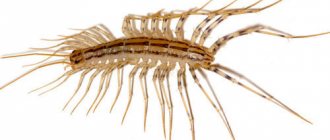Western flower parasite
- Fact:
The homeland of the Californian pest is America, its Northern and Central parts, where the presence of thrips is ubiquitous, from Mexican territories to the coast of Alaska. - Fact 2:
It was recorded in Europe in 1983. Since then, the insect has taken over the entire European continent, and has also been found in Russia since the 90s. - Fact 3:
The female lays eggs in the leaves, in specially gnawed holes or at the top of the stem. Over the course of a month, it lays up to 30 dozen eggs. When feeding on pollen, the clutch increases.
This small, terribly harmful insect is widespread throughout Russia in all regions, without exception. The danger of its vital activity is twofold: it affects almost any planting and carries severe viral plant diseases.
Appearance and general characteristics
This pest is at the top of the list of parasitic insects encountered by specialists from the Department of Quarantine in Crop Production. Thrips larvae are found both in food shipments and in flowers intended for sale, that is, in considerable volumes .
The homeland of the Californian pest is America, its Northern and Central parts, where the presence of thrips is ubiquitous, from Mexican territories to the coast of Alaska. It got its name due to the first place of discovery, that is, California. However, local scientists suggest that thrips was brought accidentally with flower crops from some South American country. It was recorded in Europe in 1983. Since then, the insect has taken over the entire European continent, and has also been found in Russia since the 90s.
An adult specimen is up to 2 mm, with a narrow yellow-headed body. The body itself can be light, yellowish or brown, rich. The wings have darkened areas. The larval form is similar to the mature one, but smaller in size and lighter in color.
California thrips prefer to overwinter in greenhouse conditions. Adult insects hide under plant waste, and the larvae burrow into the soil. In the southern regions it can overwinter in open ground. Activated after planting seedlings .
The female lays eggs in the leaves, in specially gnawed holes or at the top of the stem. Over the course of a month, it lays up to 30 dozen eggs. When feeding on pollen, the clutch increases. After hatching, the larva goes through two development cycles on the plant itself, feeding on it, and on the third it goes into the soil. The total development time from egg to adult pest is 2.5-3 weeks. Under good conditions, up to 15 generations take place per year.
Distribution area
The pest’s homeland is North America (California), and its name was chosen from the place where flower thrips was first recorded. Along with imported plants, insects spread throughout the world. Now they are found in Europe, Australia, Africa, and have been spotted across a vast territory of Asia. The pest appeared in Europe in 1983 and spread throughout all countries in record time. In the early 90s, Western flower thrips were spotted in Russian greenhouses. The quarantine object is registered in several regions of the Russian Federation: Kursk, Ulyanovsk, Moscow, Kaliningrad and others.
Danger and harm to the plant
The first thing that appears from the life of flower thrips is yellow spotting and roughness on the leaves. Over time, the lesions grow and the spots merge, and the leaf dries out and dies.
During massive attacks, the stems are bent, young shoots are deformed, grow poorly, and entire areas of damaged plants are visible. When feeding on flower buds, the color curls, the bud does not open and it dries out . When pollen feeds, flower formation stops. As a result, the yield drops significantly, the presentation is lost, and the cost decreases.
When fruit crops are damaged, the picture is no better. Silvery stripes form on fruits and berries, color and shape change, deformation occurs and holes appear. Thrips spread a very dangerous disease to tomatoes - spotted wilt. The main symptoms of the virus are yellow spotting and dark areas on the stems. To transmit infection to a crop, it is enough for thrips to suck the juice from it for half an hour.
Chemicals
In case of mass infection of plants, it is recommended to resort to insecticides. They will destroy not only the imago, but also the deposited larvae:
- "Aktara". A broad-spectrum product that is used not only to treat the plant itself, but also the soil. Effective at the early stage of infection.
"Fitoverm". A drug that has good results in the fight against many types of pests. For treatment, two ml of the product is enough, which is diluted with a glass of water. "Aktellik". A highly effective insecticide that quickly and easily kills thrips. One ampoule of the product is dissolved in a liter of water and sprayed on indoor plants. "Vermitek". A product that eliminates and permanently protects against the reappearance of pests. Two and a half ml of the product are diluted in a bucket of water and the infected areas are treated.
Plants are treated outdoors or in a well-ventilated area. After using any of the chemicals, the flower is covered with a plastic bag for a day. Repeated treatment is carried out after 10 days.
Nuances and difficulties when fighting
The extermination of thrips is difficult even when using pesticides:
1. It is difficult to achieve direct contact between the insecticide and the pest, since insects hide in plant parts (bud, flower, stem, bark, scales).
2. Immunity to many chemicals, which thrips developed in its homeland, America. For greenhouse (the most common) thrips, there are no products that can be combined to control other parasitic insects.
Ways to control California flower thrips:
- Mechanical . Covering potential victim plants with fine mesh netting. It is also installed on window, doorways, and ventilation grilles.
- Agrotechnical . Constant monitoring, removal of affected plants, regular weeding, traps.
- Biological . Colonization of the soil with special types of mites and bugs. They will not get rid of the pest completely, but they will greatly reduce its population. Moreover, biodestroyers eat not only larvae, but also adult thrips.
- Chemical . Using several chemicals specifically formulated to control the small pest. These products are very toxic and are used two, less often three times at intervals of several days.
Although the destruction of thrips is difficult and not always successful, it is necessary to fight it. Who, besides you, will protect your green plantings from the invasion of the insidious, gluttonous and prolific “immigrant” from the West.
Description of the pest
Western California thrips (photo can be seen in the article) is a member of the thrips family of the genus Frankliniella. Body length does not exceed 1.5 mm. The color is pale yellow or brown. The body is elongated, smooth. The palps consist of three segments, the antennae - of eight. The edge of the forehead is shifted towards the mouth. The mouth cone is of a piercing-sucking type, which is typical for parasitic insects on plants. In females, the ovipositor is bent downwards.
The abdomen, consisting of 10 segments, has a serrated comb on the eighth tergite. The limbs are shortened, running, and there are bubble-shaped suckers at the ends of the legs. Thrips have a pair of narrow, long wings with pointed tips. They have cilia along the edges. Thanks to this wing structure, thrips are able to fly from place to place in search of food and while laying eggs. Insects have pronounced sexual dimorphism, the female is larger in size.
Your own supervision
If you cut a cabbage head or onion and saw something dark inside (and wintering specimens are usually like that) that also started running, it’s most likely thrips. By the way, it doesn’t have to be Californian: there may be another species there, but that doesn’t make it any easier. At temperatures above +13 °C, pests can also be found on the surface. It is better not to try to eat such vegetables, since there are usually a lot of insects inside. It is possible that the leaves are already full of their eggs. If in warm weather you simply throw spoiled food into your garden compost, then thrips may fly out of it and attack your garden. Contact of infected objects with any living plants is especially dangerous.
So food or flowers with thrips should be destroyed immediately. It is more convenient to use boiling water in an apartment. But at the dacha, the easiest way is to bury an unsuccessful purchase in the ground. Having poured 10 cm of soil on top of it, you can be calm - the thrips will no longer get out.
https://www.aif.ru/dacha/ogorod/kaliforniyskiy_trips_chem_on_strashen_dlya_dachnikov?utm_source=aif&utm_medium=free&utm_campaign=main
| The most interesting AiF articles on Telegram - fast, free and without advertising |
Literature
- Izhevsky S. S.
[https://www.sevin.ru/invasive/publications/izhevsky_96.html Western flower thrips] (Russian) // Plant protection and quarantine: Journal. - 1996. - No. 2. - P. 34-35. - Ananthakrishnan TN
Order Thysanoptera // [https://books.google.co.uk/books?id=KHt-daXqZ-sC&pg=PA444 General and Applied Entomology]. — 2nd. - Tata McGraw-Hill, 2004. - P. 443–457. — ISBN 978-0-07-043435-6. - Del Bene G., Gargani E.
A contribution to the knowledge of Frankliniella occidentalis (in Italian) // Redia. - 1989. - Vol. 72. - P. 403–420. - Mantel WP
Bibliography of the western flower thrips, Frankliniella occidentalis (English) // Bulletin SROP. - 1989. - Vol. 12. - P. 29-66. - Mound Laurence A.
[https://www.annualreviews.org/doi/abs/10.1146/annurev.ento.49.061802.123318 Thysanoptera: diversity and interactions] (English) // Annual Review of Entomology: Journal. - Palo Alto, USA: Annual Reviews, 2005. - Vol. 50. - P. 247-269. — ISSN [https://www.sigla.ru/table.jsp?f=8&t=3&v0=0066-4170&f=1003&t=1&v1=&f=4&t=2&v2=&f=21&t=3&v3=&f=1016&t=3&v4=&f =1016&t=3&v5=&bf=4&b=&d=0&ys=&ye=&lng=&ft=&mt=&dt=&vol=&pt=&iss=&ps=&pe=&tr=&tro=&cc=UNION&i=1&v=tagged&s=0&ss=0&st=0&i18n =ru&rlf=&psz=20&bs=20&ce=hJfuypee8JzzufeGmImYYIpZKRJeeOeeWGJIZRrRRrdmtdeee88NJJJJpeeefTJ3peKJJ3UWWPtzzzzzzzzzzzzzzzbzzvzzpy5zzjzzzzzzzzzzzzzzzzz zzzzzzzzzzzzztzzzzzzzbzzzzzzzzzzzzzzzzzzzzzzzzzzzzzzzzzyeyTjkDnyHzTuueKZePz9decyzzLzzzL*.c8.NzrGJJvufeeeeeJheeyzjeeeeJh*peeeeKJJJJJJJJJmjHvOJ JJJJJJJfeeeieeeeSJJJJJSJJJ3TeIJJJJ3..E.UEAcyhxD.eeeeeeuzzzLJJJJ5.e8JJJheeeeeeeeeeeeyeeK3JJJJJJJJ*s7defeeeeeeeeeeeeeeeeeeeeeeeeeSJJJJJJJJZIJJzzz1..6LJJJJJJtJJ Z4….EK*&debug=false 0066-4170]. - Nakahara, Sueo.
Annotated list of the Frankliniella species of the world (Thysanoptera: Thripidae) (English) // Contributions on Entomology, International: Journal. - 1997. - Vol. 2, no. 4. - P. 355-389. - Nickle, David A.
Commonly intercepted thrips (Thysanoptera) from Europe, the Mediterranean, and Africa at US ports-of-entry. Part II. Frankliniella Karny and Iridothrips Priesner (Thripidae) // Proceedings of the Entomological Society of Washington: Journal. - 2004. - Vol. 106, no. 2. - P. 438-452. - Waterhouse, D. F. and K. R. Norris.
Chapter 4 Frankliniella occidentalis (Pergande). pp. 24-35. In: Biological Control Pacific Prospects - Supplement 1. - Canberra: Australian Center for International Agricultural Research:, 1989. - P. 1-123.
Prevention
Preventive measures will help protect plants from various types of thrips:
- systematic inspection of plants;
- compliance with quarantine measures when purchasing seedlings, seedlings, and adult specimens;
- regular removal of weeds, including near greenhouses;
- installation of small protective nets in greenhouse structures;
- compliance with crop rotation;
- thorough cleaning of tops and plant debris;
- Digging the soil before the onset of winter.
Folk remedies
Where to start a flower business
How to get rid of thrips? Many gardeners prefer to use folk remedies instead of industrial chemical compounds. In the initial stages they can be quite effective.
The following products are suitable for controlling thrips:
- Chopped onions and garlic are infused in a glass of water and the plants are treated every other day.
- Dried marigold flowers are poured with 500 ml of water and left to infuse for two days. After this, the infusion is filtered and the plants are treated with it.
- 50 grams of fresh dandelion roots or leaves are poured with a liter of warm water and infused for three hours. After filtering the prepared mixture, treat the affected plant.
- 100 grams of chamomile are poured into a liter of water and infused for 12 hours. After filtering, add 5 grams of liquid soap to the resulting mixture. The solution is used to treat plants. The product is washed off after a day under a warm shower.
- Half a glass of dry tobacco is poured with a liter of water and left to infuse for a day. The finished product is filtered and another liter of water is added to it. This infusion should be sprayed on the affected plants.
- Pour 50 grams of dry tomato leaves into a glass of water and leave for three hours. After filtering, add up to a liter of water to the infusion. The prepared mixture is sprayed onto the affected plants.
- Mix 100 grams of dry celandine with 1 liter of water and leave for 24 hours. After this, the solution is filtered and used to treat plants.
In some cases, spraying is not suitable for thrips control. Then you can use other methods of getting rid of pests. For example, turpentine or chopped garlic helps very well. They should be placed in a small container and placed directly in the pot with the diseased plant, covered with plastic wrap on top and left in this state for three hours.
How to spot thrips
photo from onfloriculture.wordpress.com
The first colony of insects to appear on indoor flowers or vegetables can remain invisible for a long time. Thrips lead a secretive lifestyle, initially staying on the same plant.
You should be alert if pollen falls off the flowers without exposure to wind and pollinating insects, and small whitish and silvery spots appear on the leaves.
To accurately determine whether a plant has pests, pick a flower and shake it over a sheet of white paper. You can also “lure them out” with a piece of fresh cucumber or apple, placing it on the ground next to the stem. Thrips will come running for such a treat.
In case of severe infection, it is enough to turn away the back side of the leaf: they usually accumulate there.
